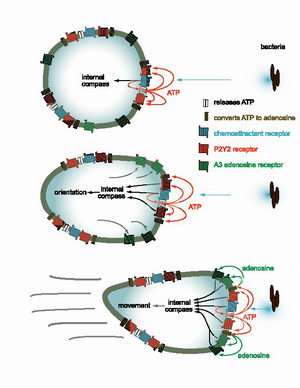Researchers discover internal compass of immune cell

Researchers at the University of California, San Diego (UCSD) School of Medicine have discovered how neutrophils – specialized white blood cells that play key roles in inflammation and in the body's immune defense against bacteria – navigate to sites of infection and inflammation. These findings could potentially lead to new treatments for serious infections and inflammatory diseases in patients.
The research, reported in the December 15, 2006 issue of the journal Science, describes the elements of the "internal compass" that neutrophils use to detect and migrate towards chemoattractants, markers of infection and inflammation that are released from bacteria and inflamed tissues.
"These findings solve the long-standing puzzle of how neutrophils find their way and move toward sites of injury or infection in the body," said senior author Wolfgang Junger, Ph.D., adjunct professor of surgery at UCSD Medical Center.
His team set out to identify the key mechanisms of signal amplification that must occur in order for neutrophils to detect the low-level activating signals (chemoattractants) sent out by bacteria at injury sites. They found that neutrophils possess a built-in amplification system that is an integral part of the internal compass the cells use to locate the source of chemoattractants. At the core of the amplification system is the chemical adenosine triphosphate (ATP).
The chain of events necessary to direct the neutrophils toward its goal begins when ATP is released from the region of the cell surface closest to the source of chemoattractants. Next, ATP binds to a nucleotide receptor called P2Y2 on the cell surface, a step critical to position the cells in the direction of the source of chemoattractants.
Once this internal compass has been activated, ATP is converted by the cells to adenosine, which in turn activates A3 adenosine receptors concentrated at the front of cells, providing the signal to move toward the source of chemoattractants.
Lead authors Yu Chen, M.D., UCSD postgraduate researcher in surgery and Ross Corriden, UCSD graduate student in biomedical sciences, found that when ATP receptors were blocked, the cells became disoriented, while blocking A3 adenosine receptors slowed down the cell movement toward chemoattractants. The researchers also found that drugs which interfere with the amplification system impair cell migration to inflamed tissues.
"These findings are very important because they suggest that novel classes of anti-inflammatory drugs could be developed to prevent rheumatoid arthritis, inflammatory bowel diseases, asthma, and many other chronic inflammatory diseases," said Junger.
Conversely, drugs that boost these amplification systems and the internal compass could be used to coax neutrophils to migrate to infected wounds to improve wound healing.
Source: University of California - San Diego




















